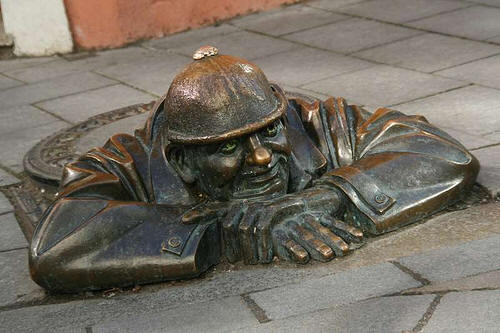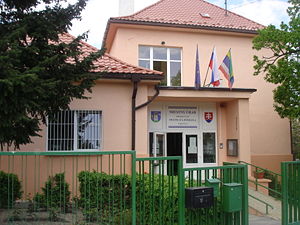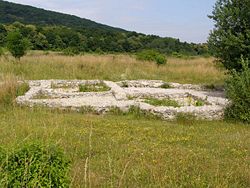
Bratislava
About Bratislava
Bratislava is the capital city of Slovakia. There live 427 000 people in this city. Bratislava is in the south-western Slovakia on both banks of the River Danube. This city is the political, cultural and economic centre of Slovakia. It is the seat of the parliament, the Slovak president, Slovak government and mayor of Bratislava.
History
Romans built in territory of Bratislava part of the Limes Romanus in the 4th century. In the 10th century, the territory of Bratislava became a part of Hungary and became a key economic and administrative centre on the kingdom's frontier. This strategic position destined the city to be the site of frequent attacks and battles, but also brought it economic development and high political status. Bratislava (then Pressburg) was granted its first known town privileges in 1291 by Andrew III, and was declared a free royal town in 1405 by King Sigismund of Luxemburg. In 1993, the city became the capital of the newly formed Slovak Republic.
Government
Bratislava is the seat of the
Slovak parliament, presidency, ministries, mayor of Bratislava, Supreme Court
and central bank. The mayor, based at the Primate's Palace.
Bratislava is divided into five districts:
Bratislava I (the centre of city)
Bratislava II (eastern parts)
Bratislava III (north-eastern parts)
Bratislava IV (western and northern parts)
Bratislava V (southern parts on the right bank of the Danube)
Science
The first university in
Bratislava was Academy Istropolitana. It was founded in 1465 by King Matthias
Corvinus. Bratislava is the seat of the largest university (Comenius
University), the largest technical university (Slovak University of Technology),
and the oldest art
schools.
Architecture of city
For a tourist or a native inhabitant, there are many buildings to see and many nice places to visit:
The Bratislava Castle
One of the most prominent structures in the city is Bratislava Castle. The castle hill site has been inhabited since the transition period between the Stone and Bronze ages] and has been the acropolis of a Celtic town and part of the Limes Romanus.
|
|
|
|
The Devín Castle
The ruined and recently renovated Devín Castle is in Devín, on the top of a rock where the Morava River enters to the Danube.
|
|
|
|
It was destroyed by Napoleon's troops in 1809. It is an important symbol of Slovakia and Slavic history.
Slavín
Slavín is monument for soldiers from The Second World War.
|
|
|
|
St. Martin’s Cathedral
The Gothic St. Martin's Cathedral built in the 13th–16th centuries, which served as the coronation church of the Kingdom of Hungary between 1563 and 1830. Inside the cathedral, we can admire the Baroque group, as well as the Gothic and Renaissance tombstones, beautiful colourful windows and octagonal columns. St. Martin’s Cathedral has been a national cultural monument since November 11, 2002.
|
|
|
|
The Town Hall
Bratislava's Town Hall is a complex of three buildings erected in the 14th–15th centuries and now hosts the Bratislava City Museum.
|
|
|
|
The Primate´s Palace
In 1805, diplomats of emperors Napoleon and Francis II signed the fourth Peace of Pressburg in the Primate's Palace, after Napoleon's victory in the Battle of Austerlitz.
|
|
|
|
The Slovak National Theatre (old)
Bratislava is the seat of the Slovak National Theatre, housed in two buildings. The first is a Neo-Renaissance theatre building situated in the Old Town at the end of Hviezdoslav’s Square.
|
|
|
|
The Slovak National Theatre (new)
The new building, opened to the public in 2007, is on the riverfront.
|
|
|
|
The Kamzík TV Tower
Kamzík TV Tower is the unique designed tower with an observation deck and rotational restaurant.
|
|
|
|
The New Bridge Tower Café
Nový Most (New Bridge) was built in the 20th century across the Danube with a UFO-like tower restaurant.
|
|
|
|
Noteworthy statue
Rubberneck, one of the bronze statues scattered around the Old Town, peers out at tourists from the sewerage hatch.

Tourism
Every year a lot of tourists come to Bratislava. They stay in a hotel or an apartment. If you come to see Bratislava, you can visit The Slovak National Museum, the Bratislava City Museum, the Slovak National Gallery, the Bratislava City Gallery or the Slovak National Theatre.
If you wish more, you can go for the Old Town tram tour, which is a two- hour drive in an old tram that criss- crosses the city .
Media
In Bratislava there seat basic TV stations: STV 1, STV 2, STV 3, Markíza, JOJ, JOJ PLUS and TA3
Slovak Radio has its seat in the centre, and many Slovak commercial radio stations are based in the city.


 - The municipial coat-of-arms
- The municipial coat-of-arms
Dúbravka is north-western part of Bratislava. Primal timeship was then 14th century. In history have been vine gardens here.
Now, Dúbravka is the second biggest part of Bratislava.
 The local office - the seat of the mayor in Dúbravka
The local office - the seat of the mayor in Dúbravka
Monument of Dúbravka
Horánska studňa (well) - Water was in this well even if was a time of dryness.

Church of St. Kozma and St. Damián - People built this church in 1723. St. Kozma and Damián were doctors. They heal people free of cost.

Villa Rustica - Villa Rustica is national culture monument. It inhabit in Big Meadow, where archeologists found relics of Celts.

Church of Holy Spirit
The new church in Dúbravka was opened in the 2002.
